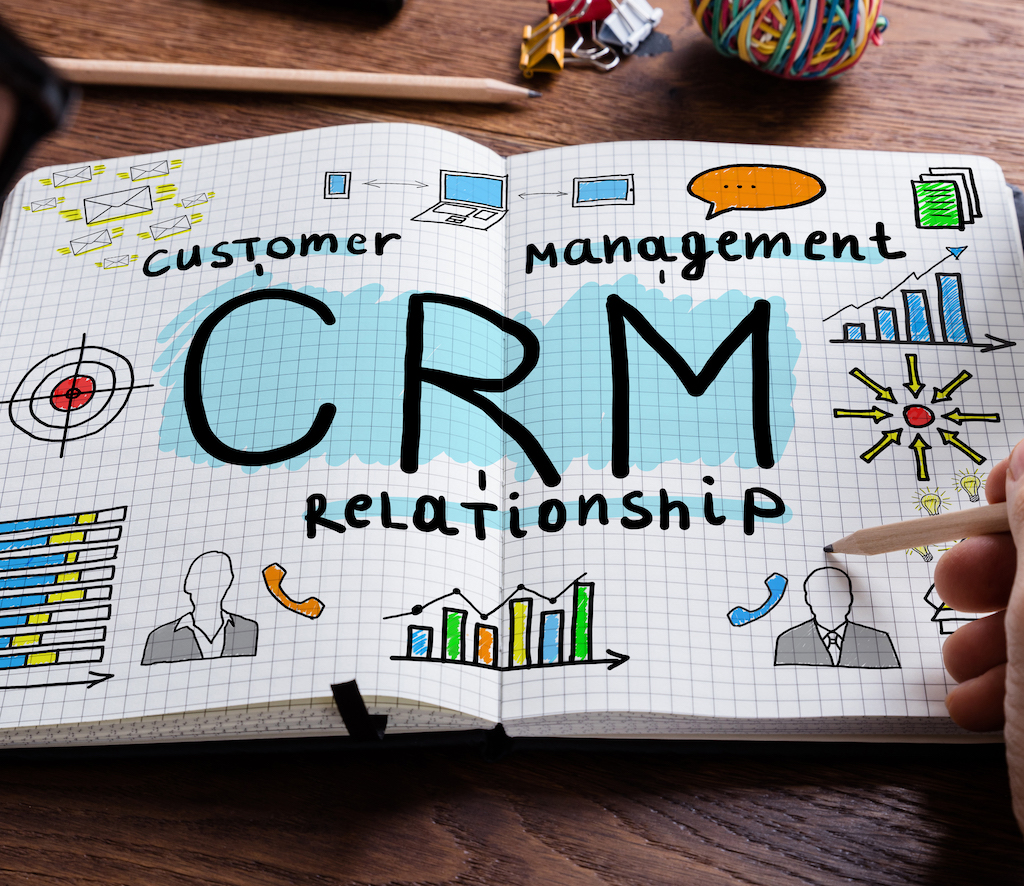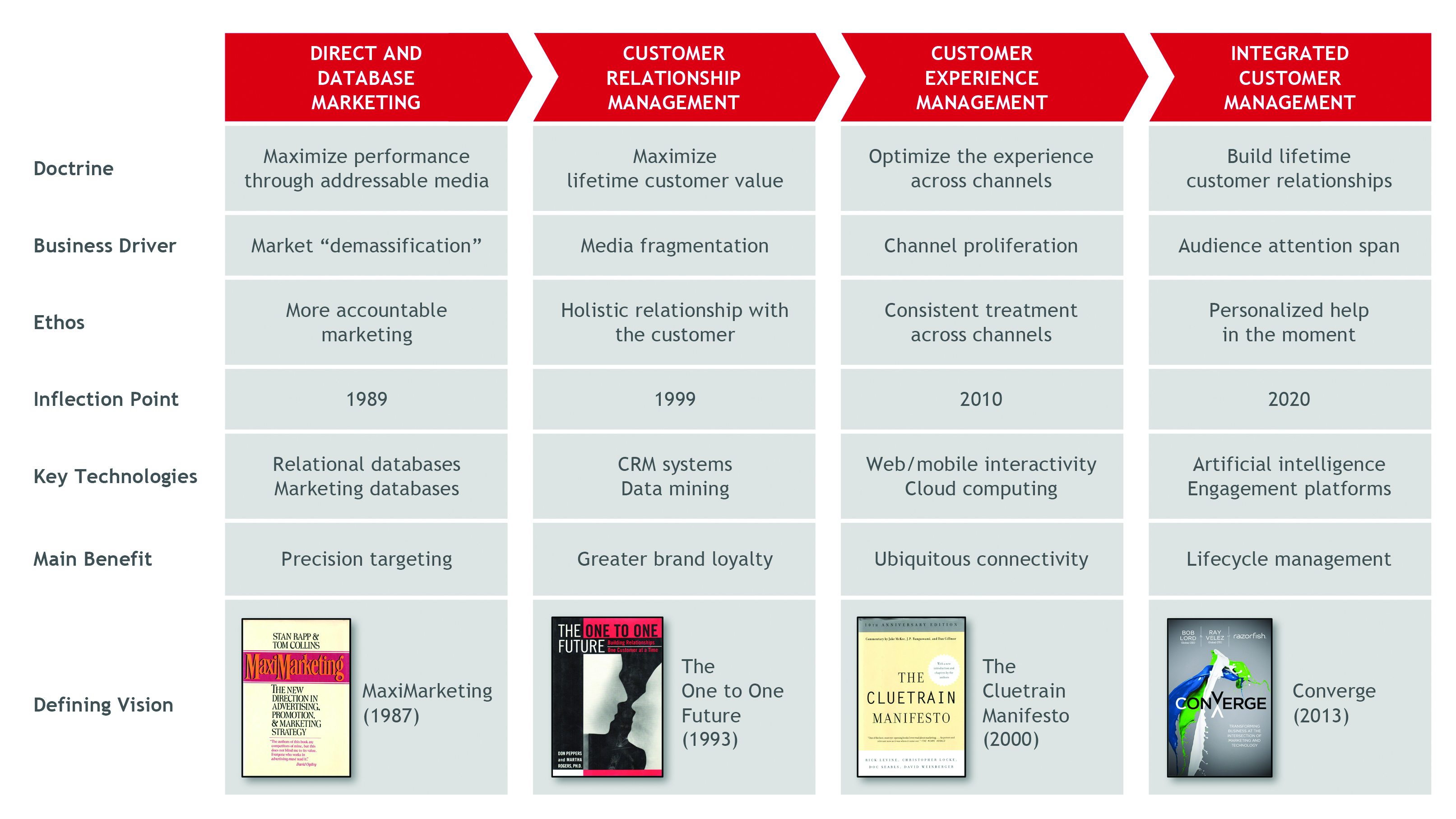The Evolution (and Future) of Relationship Marketing
Relationship marketing has taken 30 years to mature into a mainstream discipline. Today its principles and practices form the bedrock of a new marketing model based on putting customer needs first.

Just over three decades ago, the term relationship marketing quietly slipped into the business lexicon. At the time marketers were grappling with the early stages of market “demassification”, finding it much harder to reach a mass audience. Meanwhile, the introduction of marketing automation systems had made addressable media a more affordable option for targeting niche segments. And so, marketers began to explore more diversified media options in the pursuit of direct relationships with identifiable customers.
Eventually the principles and practices championed by the leading relationship marketing proponents of the time began to resonate with the broader marketing community. Those ideas have since become the bedrock of today’s new marketing model, just now beginning to coalesce around the concept of integrated customer management.
The progression from those early years of direct and database marketing to today’s world of multi-channel real-time engagement forms a long evolutionary arc, extending from the early 1980s. Over those three decades, technology has been the main catalyst for change: from the rapid growth of home PCs in the ‘80s to the invention of the web browser in the ‘90s to the mass adoption of the smartphone in the past 10 years. While historical antecedents tend to reveal themselves sloppily, one era usually bleeding into another, there are at least three distinct evolutionary periods in the history of relationship marketing, each marked by a technology-related tipping point.
The Era of Direct and Database Marketing (1989-1999)
The paycheque of most marketers was still tied to chasing sales. Yet mass advertising was already in slow decline, as audiences had begun to splinter due to media fragmentation. The burning question on marketers’ minds: how to make the best use of their media budgets. In their provocative book “MaxiMarketing”, direct marketing luminaries Stan Rapp and Tom Collins argued for more accountable marketing, principally by fostering “an ongoing relationship with the customer after the first sale by encouraging additional purchases or continued loyalty”. Five years later, in 1993, Don Peppers and Martha Rogers echoed that thinking in their best-seller “The One-to-One Future”, making the concept of “one-to-one” marketing the buzzword of the decade. Their prophetic views popularized relationship marketing as a management theory. Leading academics like Jagdish Sheth, Adrian Payne and others contributed to the reform movement, giving it their scholarly blessing, supported by Fred Reicheld’s oft-quoted research showing the correlation of loyalty to profitability (“The Loyalty Effect”, 1996). By the end of the 1990s relationship marketing had gained legitimacy as a practice area, worthy of academic study.
Tipping Point: marketing’s adoption of customer database systems.
The Era of Customer Relationship Management (2000-2010)
As the new millennium dawned, a rising chorus of contrarian voices could be heard, led by a band of digital utopians, who scoffed at old school methods of brand persuasion. They called for a more consensual relationship with customers: “Permission marketing” was what Seth Godin famously called it. Eventually they were proven right, but initially the Internet was treated by marketers as a lower caste media channel. Meanwhile, the next generation of direct marketers had come along, schooled in the use of CRM data to segment customers, and they argued just as vigorously for more personalized marketing which addressed individual needs and preferences. The era of “one size fits all” messaging was over, as far as they were concerned. Soon the widespread use of e-mail to reach customers eclipsed direct mail as the preferred communication channel. As the decade wore on, the convergence of CRM and web-based interactivity meant that marketers now had the tools to engage customers in a two-way dialogue. But most marketers – even those expert in CRM – had a tough time resisting the urge to push out brand messages indiscriminately. And it took a while before CRM could shake off its discredited image from the mid-1990s, when many early implementations failed due to a combination of inadequate systems integration, lack of process change and fierce cultural resistance, particularly amongst sales people.
Tipping Point: the transition to Web 2.0 and the Social Web.
The Era of Customer Experience Management (2010 – Present)
At the start of this current era most businesses struggled to keep up with the pace of digital transformation. Slow to embrace interactive marketing as a grown-up discipline, brand marketers were reluctant to pull dollars out of conventional paid media, afraid to dilute their awareness-building efforts. But the tectonic shift in customer behaviour simply could not be ignored anymore: people no longer needed a brand to tell them what product to buy or where to find it. They just wanted a better experience. All that ad money spent interrupting people was starting to see a diminishing return. Audiences were paying less attention, distracted by their digital devices. The brand differentiator was now the ease and memorability of the customer experience. As the lights began to flicker in print publishing and broadcast media, brand-building dollars surged into digital media, hoping to find people willing to engage. Now, as the decade draws to a close, even the most profligate ad spenders (like P&G) are pulling back, seeing “one-to-one marketing at scale” as their salvation. The Age of the Customer had officially arrived.
Tipping Point: the smartphone revolution and the proliferation of digital devices.
The Future: Integrated Customer Management (> 2020)
Over the next few years artificial intelligence will have a dramatic impact on marketing, helping to alleviate the burden and complexity of managing real-time interactions across multiple channels and devices. But first marketers must solve the riddle of the times: How do they encourage an open relationship with customers when the spectre of privacy intrusion and data piracy hangs over everyone? Just consider the recent Facebook data breach when 30 million account profiles were hijacked. And as long as marketers are still being paid to persuade, not to befriend, they will just give lip service to the idea of relationship marketing. One thing for sure: the pace of change is about to pick up speed, pressuring all marketers to pivot toward a customer-first model.
What does a new Relationship Marketing Model look like? An emerging consensus is forming on a general framework, structured around five major planning pillars:
Experience Design
In future brands will be judged by the harmony of the experience they offer, whether a customer is making first contact, seeking ongoing help, sorting out their product options or just making a purchase, online or offline. Each interaction should pick up where the last one left off. But that means dismantling the operational siloes, otherwise customers will keep falling between the cracks, never to be heard from again. That’s why the urgency for digital transformation keeps CMOs awake at night: the longer it drags on, the more likely Disruption will be knocking on their door.
Lifecycle Management:
If the old marketing model was all about guiding customers through the sales funnel, the new one is about “flipping the funnel”: allowing customers to dictate the terms of engagement. That means marketers must be able to read the buying signals customers offer, indicating where they are in the path to purchase (“just-browsing”, “deep discovery”, “tell me more”, “ready to buy”, and so on). Which is tougher than it sounds, because most customer management systems suffer from disabling blind spots, notwithstanding the advancements made in identity resolution. The surest bet for marketers is to adopt a “subscription model”, where customers opt-in to the relationship willingly, sharing as much about themselves as they feel comfortable. As trust is gained over time, marketers can use progressive profiling to fill in the blanks (assuming no data breaches occur!)
Contextual Marketing
If the old marketing model was channel-based – “above-the-line” and “below-the-line” – the new planning model has no lines. Customer interactions flow across all channels and devices in real-time. While appropriate attention is still paid to demand generation (how else do you win new customers?) marketing budgets are weighted proportionally according to expected revenue contribution from different customer segments. The goal is to deepen the emotional connection with high value customers, making them feel important and special. That means assisting them in their exact moment of need – not just when they reach out for help – through timely intervention (a suggestion, a recommendation, an alert). Customers will agree to stay connected because it will be in their interest to do so.
Brand Identity Management
The old brand-building model started with the question: “Who is our target audience and how do we reach them?” The new one begins by asking “How can we build an audience? What more should we do to earn customer trust?”. The strongest brands are integral to the lives of their customers (think Google, Amazon, Apple, Nike, Costco). They offer unique value that competitors have a tough time mimicking. Their identity is wrapped up in how they make a difference in the lives of people – what they stand for – their truthfulness and authenticity. At the heart of their story is not simply a slogan or a tagline but a heartfelt sentiment – an ethos they share with customers (e.g., Nike’s “Believe in something, even if it means sacrificing everything”) along with a narrative that explains the origin of the brand and why it matters. A story that creates believers and crusaders, not just transient belief in a self-aggrandizing message.
Performance Management
Brand marketers have traditionally worshipped at the alter of Gross Ratings Points (which explains why TV advertising remains a $70 billion business). The old marketing model measured success in terms of fleeting measures like media reach and message recall. Mapping those measures back to sales gains – which is all the CFO cares about – has always been a fanciful exercise (as most marketers will confess). But if marketing is to take charge of the customer relationship, the true measure of success is how positive customers feel about their experience: not simply how satisfied they are with the product or service, but how committed they are to the brand. If the brand is not available on the shelf, would they drive down the road to buy it? Would they resist enticements to switch? Would they forgive an occasional blunder? And measurement needs to be more integrated, capturing both behavioral indicators of loyalty (like retention rate) and attitudinal indicators, whether that’s NPS or some other diagnostic measure that goes beyond word-of-mouth. To do that, marketing needs a cascading scorecard which shows the correlation between each 1% increase in loyalty and the value of the customer portfolio. That way, even the most disbelieving CFO will see the payoff.
However, the real payoff of relationship marketing is not just measured in ROI: it comes in future-proofing the business. The next era, whatever it eventually gets named, will see more business wreckage than the last three decades combined. Old business models will simply vanish, victims of the platform economy, organizational inertia or risk aversion. Many once-prominent brands have already marched blindly into oblivion (think Kodak, Blockbuster, Xerox, Toys R Us, Borders, most recently Sears). Transformative technologies like AI, IOT, 5G and blockchain will make commercial business unrecognizable. To adapt and thrive in this world of constant, relentless change, marketers need to be closer than ever to customers. And that means one thing: developing “ongoing”, “one-to-one” relationships that survive the test of time.
